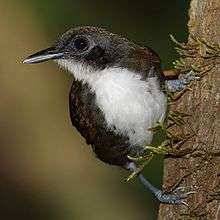Gymnopithys
Gymnopithys is a genus of passerine birds in the antbird family, Thamnophilidae.
| Gymnopithys | |
|---|---|
 | |
| Bicolored antbird (Gymnopithys bicolor) | |
| Scientific classification | |
| Kingdom: | Animalia |
| Phylum: | Chordata |
| Class: | Aves |
| Order: | Passeriformes |
| Family: | Thamnophilidae |
| Genus: | Gymnopithys Bonaparte, 1857 |
The species in this genus are specialist ant-followers that depend on swarms of army ants to flush arthropods out of the leaf litter.[1]
Taxonomy
The genus Gymnopithys was introduced by the French ornithologist Charles Lucien Bonaparte in 1857 with the rufous-throated antbird as the type species.[2][3] The name Gymnopithys combines the Ancient Greek gumnos meaning "bare" or "naked" with the name of the antbird genus Pithys that was erected by the French ornithologist Louis Jean Pierre Vieillot in 1818.[4] The white-cheeked antbird and the bicolored antbird were formerly considered as conspecific. They were split into separate species based on the results of a genetic study published in 2007 that found that the white-cheeked antbird was more similar to the rufous-throated antbird than it was to the bicolored antbird.[5][6]
The genus contains three species:[7]
- Rufous-throated antbird, Gymnopithys rufigula
- Bicolored antbird, Gymnopithys bicolor
- White-cheeked antbird, Gymnopithys leucaspis
The genus previously included the white-throated antbird and the lunulated antbird but when a molecular phylogenetic study published in 2014 found that Gymnopithys was polyphyletic, these two species were moved to a new genus Oneillornis to create monophyletic genera.[7][8]
References
- Zimmer, K.; Isler, M.L. (2018) [2003]. del Hoyo, J.; Elliott, A.; Sargatal, J.; Christie, D.A.; de Juana, E. (eds.). "Typical Antbirds (Thamnophilidae)". Handbook of the Birds of the World Alive. Lynx Edicions. Retrieved 17 February 2018.
- Bonaparte, Charles Lucien (1857). "Catalogue des oiseaux recuellis a Cayenne". Bulletin de la Société linnéenne de Normandie (in French). 2: 29–40 [35].
- Peters, James Lee, ed. (1951). Check-list of Birds of the World. Volume 7. Cambridge, Massachusetts: Museum of Comparative Zoology. p. 246.
- Jobling, James A. (2010). The Helm Dictionary of Scientific Bird Names. London: Christopher Helm. p. 182. ISBN 978-1-4081-2501-4.
- Brumfield, R.T.; Tello, J.G.; Cheviron, Z.A.; Carling, M.D.; Crochet, N.; Rosenberg, K.V. (2007). "Phylogenetic conservatism and antiquity of a tropical specialization: Army-ant-following in the typical antbirds (Thamnophilidae)". Molecular Phylogenetics and Evolution. 45 (1): 1–13. doi:10.1016/j.ympev.2007.07.019.
- Freeman, Ben (September 2013). "Proposal (587): Split Gymnopithys leucaspis into two species". South American Classification Committee of the American Ornithological Society. Retrieved 16 March 2018.
- Gill, Frank; Donsker, David, eds. (2017). "Antbirds". World Bird List Version 8.1. International Ornithologists' Union. Retrieved 30 January 2018.
- Isler, M.L.; Bravo, G.A.; Brumfield, R.T. (2014). "Systematics of the obligate ant-following clade of antbirds (Aves:Passeriformes: Thamnophilidae)". Wilson Journal of Ornithology. 126 (4): 635–648. doi:10.1676/13-199.1.